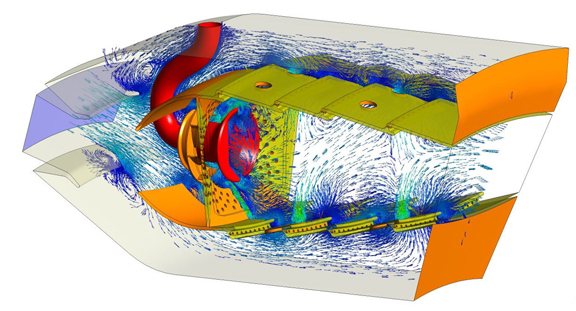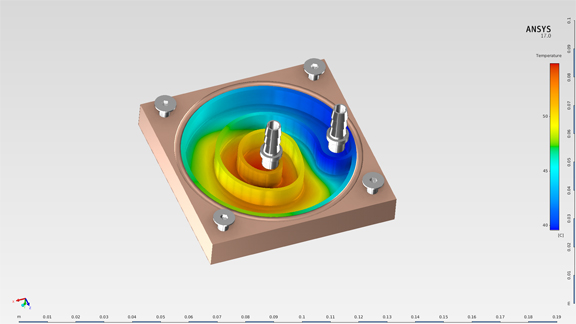
The groundbreaking breakthrough in scalability (129,000 cores at 90 percent efficiency) has been achieved by working with Cray, the National Center for Supercomputing Applications (NCSA) and the National Energy Research Scientific Computing Center (NERSC). The Fluent model is a gas turbine combustor involving transient, turbulent flow, mixing of multiple chemical species and turbulence-chemistry interaction
January 27, 2016
 The breakthrough in scalability (129,000 cores at 90% efficiency) in ANSYS 17.0 has been achieved by working with Cray, the National Center for Supercomputing Applications (NCSA) and the National Energy Research Scientific Computing Center (NERSC), according to ANSYS. The Fluent model is a gas turbine combustor involving transient, turbulent flow, mixing of multiple chemical species and turbulence-chemistry interaction.
The breakthrough in scalability (129,000 cores at 90% efficiency) in ANSYS 17.0 has been achieved by working with Cray, the National Center for Supercomputing Applications (NCSA) and the National Energy Research Scientific Computing Center (NERSC), according to ANSYS. The Fluent model is a gas turbine combustor involving transient, turbulent flow, mixing of multiple chemical species and turbulence-chemistry interaction. Simulating the temperature on a chip cooling system with ANSYS 17.0.
Simulating the temperature on a chip cooling system with ANSYS 17.0.This week, ANSYS unveils what it describes as “most feature-rich release in the company’s 45-year history”—ANSYS Release 17.0.
“Peter Bilello, president of CIMdata, said, “As the industry moves ahead over the next decade to realize the vision and promised benefits of Model-Based Systems Engineering in the context of mega-trends such as the Internet of Things (IoT), Industry 4.0, and the Circular Economy, ANSYS’ product portfolio and M&S platform is well positioned to meet the multi-domain requirements for developing complex cyber-physical systems with ever increasing levels of software and electronics content.”
In a nod to the growing importance of electronics in connected devices, the new release features “tighter integration of semiconductor and electronics simulation solutions” and “a comprehensive chip-package-system design workflow,” the company announces. 17.0 lets engineers import ECAD geometry and perform coupled thermal-structural analysis to verify power integrity, electronics cooling, stress, deformation, and fatigue.
The 10X performance improvement comes from “modern HPC solver architecture that leverages the latest processor technologies,” ANSYS explains. The company points out, “ANSYS fluids solutions have smashed the previous simulation world record by scaling to 129,000 compute cores running at 90% efficiency—a 10x improvement over the past two years. HPC performance of the structures suite has also improved significantly and now demonstrates scaling up to 1000 cores. Structural simulations which required running overnight, can now be completed in an hour.”
The dramatic improvement is achieved by working with Cray, the National Center for Supercomputing Applications (NCSA) and the National Energy Research Scientific Computing Center (NERSC), ANSYS reveals.
Scott Misage, HP’s VP and general manager of High Performance Computing (HPC), said, “By bringing together all HPC advances made in the new ANSYS 17 release with our industry-leading HPE Apollo compute platform for HPC and big data workloads, our customers can now transform their product development processes, reduce engineering costs and accelerate time-to-market.”
In 2015, ANSYS released ANSYS AIM, an environment that’s intended to “bring simulation to every engineer.” In Release 17.0, AIM returns with an “easy-to-use, integrated workflow that rapidly transfers geometric changes throughout the simulation, streamlining the simulation process and accelerating the evaluation of multiple design alternatives,” the company writes. The new version of AIM comes with “realistic material rendering” so the analysis model and simulation results “look like their real-world counterpart.”
To facilitate system-level simulation—an approach that requires different disciplines to collaborate on simulation the entire system as a whole—ANSYS 17.0 includes native support of Modelica, the standard language for modeling complex, multidomain systems. According to ANSYS, “Simplorer 17.0 enables you to perform simulations with over 1,500 additional components from the Modelica Standard Library and Hydraulics and Pneumatics Libraries from Modelon.”
For more on ANSYS 17.0, visit the product’s dedicated page here.
Subscribe to our FREE magazine, FREE email newsletters or both!
About the Author
Kenneth Wong is Digital Engineering’s resident blogger and senior editor. Email him at [email protected] or share your thoughts on this article at digitaleng.news/facebook.
Follow DERelated Topics






